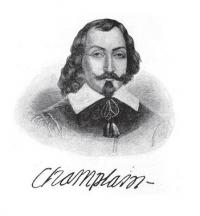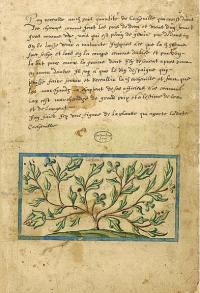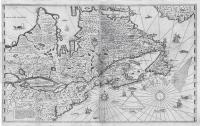Main Sections
Front Page
SportsValley VitalsIt's in the StarsStarwiseArchivesLinksAbout The VoiceContact Us
|
In The Shadow Of A Lake And A Man
Understanding The Complex Puzzle That Was Samuel de Champlain

photo provided Samuel de Champlain looks through time to the Lake Champlain region his
explorations so greatly impacted. |
| 
photo provided Besides being a map maker, Champlain’s journals record local fauna, weather patterns, and interactions with Native tribes. |
| 
photo provided As much a map maker as an explorer, this part of Champlain’s 1632 Map of New France offers a glimpse into early life in the region, both European and Native tribes. |
|
Tuesday February 16, 2010
By Cookie Steponaitis
We boat, fish and swim in its waters. We bask in the glorious sunshine and on its beaches all summer long. We watch it’s ever changing hues of blue and white as the winter snows and ice blanket its surface. We cross it to reach New York and we reel as the demolition of a bridge severs a link between two states that share its shores. We even name parks and statutes after its namesake, but just how often do we stop to ponder the history, power and role of not only the lake, but of the European who discovered its power and strategic location over four hundred years ago? Samuel de Champlain lived at a time when the waterways of the world were highways. Faster and more passable than any foot trails in the wilderness they provided the avenue for commerce and movement of people and equipment. However the new explorers of the time viewed the waterways of this vast continent as paths to riches, trade and adventures. Champlain observed the waterways to be the doorways through which few had ever passed. Unlike many of his time, Champlain’s writings are full of musings and philosophical questioning focusing on the impact of his finds, interactions and decisions. He wrote with an eye for natural detail while reflecting on how his journeys were altering the directions of the people he met and the nation he represented. Lake Champlain became a crucible of change and turmoil in American history.
During his travels Champlain not only discovered the lake that now bears his name but started the settlement of Quebec. His maps of most of northeastern America were important to the development of the early French colonies in the New World. Champlain’s maps, ideas and style of governance resulted in lasting changes that were in place until long after his death. He was a member of the Francois Du Pont expedition in 1603 and sailed the St. Lawrence River mapping most of the Gaspe Peninsula while searching for the famed Northwest Passage. Upon returning to the new lands he became a member of the Pierre de Mont expedition that sailed from Nova Scotia, a colony he was instrumental in establishing, to what is modern day Rhode Island during 1604-1607. After a bitter and death filled winter in Quebec in 1608 in which only nine of the 32 colonists survived, Champlain set his eyes south and began his travels that earned his namesake of Lake Champlain and brought him center stage in the stories of early partnerships between the French and the Huron Indians.
Champlain writes in his journals about the July 20, 1609 battle between his troops, the Huron Indians he had befriended and the neighboring Iroquois. “As soon as we were ashore they began to run about 200 paces ahead of their enemy, who were standing firmly and had not yet noticed my companions, who went into the woods with some savages. Out men began to call me with loud cries; and , to give me a passageway, they divided into two parts and put me at their head, where I marched about twenty paces in front of them until I was thirty paces from the enemy. They at once saw me and halted, looking at me, and I at them. When I saw them making a move to shoot at us, I rested my arquebus against my cheek and aimed directly at one of the three chiefs. With the same shot two of them fell to the ground, and one of their companions, who was wounded and afterward died. I put four balls into my arquebus. When our men saw this shot so favorable for them, they began to make cries so loud that one could not have heard it thunder….. This place, where this charge was made, is in latitude 43 degrees and some minutes, and I named the lake, Lake Champlain.” (Champlain diary, translated by Annie Nettleton Bourne, 1906, vol. 2). His entry documents the beginning of the era that spanned over 150 years of hostilities between the two native tribes and two European nations and the role of Lake Champlain in those struggles.
During his lifetime Champlain would return to the region again to explore the Georgian Bay, Lake Huron, Lake Ontario and travel to the Quebec settlement for years. While his impact is often connected to the exploration and use of the lake that he named, it was more widespread. He established the pattern of French interaction with the native tribes and the fur trade that would dominate the region until the exhaustion of the beaver supplies. His actions and interactions put in motion the exploration of all the rivers feeding the Lake Champlain Basin and introduced European weaponry and culture into the native tribes. Unknowingly, he elevated the importance of the lake and all of its tributaries to be used as military routes for the coming seventy five years and was the front runner for slews of fur traders, explorers and missionaries that would follow.
Leaving behind his journals, his sketches and the land marks that bear his name and imprint, Champlain vanished into history and was largely unread and noticed for a long time. The recent Quadricentennial celebration of his discovery of the lake shed light and interest on this complex man whose actions continue to echo through time. The bonds that exist between the people of Quebec and the Champlain Valley are deeply rooted and are represented today in heritage, song and celebration. The remarks and reflections of Champlain, the man and explorer, spotlight the motivating forces and impact of this time in history in the area two different nations would come to call home. As Champlain wrote in a letter to the French queen in 1609, “In inclinations of men differ according to their varied dispositions; and each one in his calling has his particular end in war. Some aim at gain, some at glory, and some at the public weal. The greatest number is engaged in trade, and especially that which is transacted on the sea. Hence arise the principal support of the people, the opulence and honor of states.”
The next time you stand at the shores of Lake Champlain and gaze at its unique beauty, take a moment to step back in time. Hear the slap of the oars in the water of the canoes of Champlain and his men. See the area through his eyes and look once again at the history of the region Vermonters take so much in stride, but not in context. The lake holds many secrets, many treasures and many reflections of the European man who sailed it for the first time, so long ago.
|
Advertisements
Search our Archives
|

 Printer Friendly
Printer Friendly



